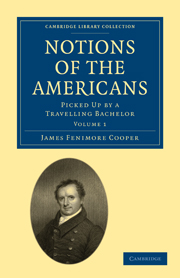Book contents
- Frontmatter
- PREFACE
- Contents
- LETTER I To Sir Frederic Waller
- LETTER II To the Baron Von Kemperfelt
- LETTER III To the Same
- LETTER IV To the Same
- LETTER V To Sir Edward Waller, Bart
- LETTER VI To the Same
- LETTER VII To the Same
- LETTER VIII To the Baron Von Kemperfelt
- LETTER IX To the Count Jules de Béthizy
- LETTER X To the Same
- LETTER XI To the Same
- LETTER XII To the Same
- LETTER XIII To the Same
- LETTER XIV To Sir Edward Waller, Bart
- LETTER XV To the Same
- LETTER XVI To the Same
- LETTER XVII To the Same
- NOTES
LETTER VII - To the Same
Published online by Cambridge University Press: 05 August 2011
- Frontmatter
- PREFACE
- Contents
- LETTER I To Sir Frederic Waller
- LETTER II To the Baron Von Kemperfelt
- LETTER III To the Same
- LETTER IV To the Same
- LETTER V To Sir Edward Waller, Bart
- LETTER VI To the Same
- LETTER VII To the Same
- LETTER VIII To the Baron Von Kemperfelt
- LETTER IX To the Count Jules de Béthizy
- LETTER X To the Same
- LETTER XI To the Same
- LETTER XII To the Same
- LETTER XIII To the Same
- LETTER XIV To Sir Edward Waller, Bart
- LETTER XV To the Same
- LETTER XVI To the Same
- LETTER XVII To the Same
- NOTES
Summary
The six North Eastern States of this great union compose what is called New England. The appellation is one of convention, and is unknown to the laws. It is a name given by a King of England, who appeared willing to conciliate that portion of his subjects, who had deserted their homes in quest of liberty of conscience, by a high-sounding title. It will be remembered that colonies of the Dutch and Swedes, at that time, separated the northern possessions of the English from those they held in Virginia. It is most probably owing to the latter circumstance that the inhabitants of the New England provinces so long retained their distinctive character, which was scarcely less at variance with that of the slave-holding planters of the south, than with that of their more immediate neighbours, the Dutch. The pacific colonists of Penn brought with them but little to soften the lines of distinction, and after New York became subject to the Crown of Britain, it was a mélange of Dutch quietude and English aristocracy. It was not until the Revolution had broken down the barriers of provincial prejudices, and cleared the way for the unrestrained exercise of the true national enterprise, that these territorial obstacles were entirely removed, and a thorough amalgamation of the people commenced. A few observations on the effect of this amalgamation, and the influence it has had on the character of the nation, may not be thrown away here.
- Type
- Chapter
- Information
- Notions of the AmericansPicked Up by a Travelling Bachelor, pp. 120 - 147Publisher: Cambridge University PressPrint publication year: 2009First published in: 1828



